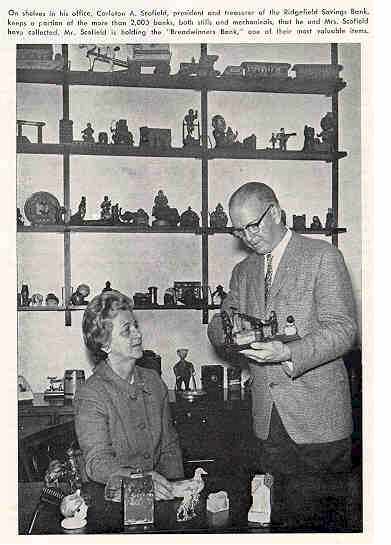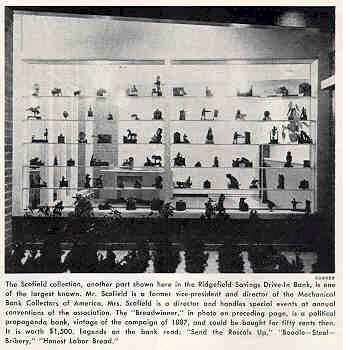Banker's Hobby - bank collecting
By Irma Scofield - FAIRFIELD COUNTY Magazine - January, 1968
 A
mule that bucks - a dog that snaps - a man that swallows a coin. Well, money boxes, coin
containers, penny banks - depends on where you live. (I asked for penny banks in a shop in
Bermuda and they didn't know what I meant.)
A
mule that bucks - a dog that snaps - a man that swallows a coin. Well, money boxes, coin
containers, penny banks - depends on where you live. (I asked for penny banks in a shop in
Bermuda and they didn't know what I meant.)
The first few banks you acquire are rare fun, the next few, even more exciting, and from
there on - you're hooked!
Eleven years ago I had no idea what a mechanical bank was, thought I did know a
"still" when I saw one. I was aware of banks that were sold in retail stores,
but as far as antique banks were concerned, I knew nothing and neither did my better half,
but we have both learned and are still learning.
Being auction buffs, and always inspecting the goods the day before, we came upon two
banks, both mechanical, " 'Spise a Mule" and "Tammany." The thought
passed through my husband's mind that these banks would be nice for decoration in the new
Drive-In Bank under construction at that time. He instructed me to buy them if I went to
the sale. I went, I bought, and came home with two broken banks that I had bid too much on
- but I had them! I promptly went to a lawnmower repair shop and came out with the banks
repaired, so to speak, with several huge gobs of solder very prominently stuck to both of
them. Bank collectors know that this is the worst thing I could have done, outside of
repainting them - but we all have to learn by doing, and I did.
 Well,
from that time on, right to the present, we have traveled many miles in this country and
foreign countries, through antique shops, flea markets, junk yards, and anywhere else
where we think we might come up with a bank. We advertise in national magazines and answer
many letters from all parts of the country.
Well,
from that time on, right to the present, we have traveled many miles in this country and
foreign countries, through antique shops, flea markets, junk yards, and anywhere else
where we think we might come up with a bank. We advertise in national magazines and answer
many letters from all parts of the country.
We have chased many leads down only to find that the bank that was to be "that little
sleeper" was nothing but a reproduction disguised to look real and authentic.
Incidentally, there are many of these around, mixed in with authentic banks, so buyer
beware!
Just to show you how small the world is, we received a letter from a dealer out in the Far
West telling us that he had just come from a buying trip to England, and he had a bank he
thought we would be interested in. It was the "Football Bank," and he quoted a
price and offered to send it for inspection. As we did not have this rare bank, we could
hardly wait until it arrived, not really believing it would be the real one. But it was, a
beautiful bank that we were thrilled with. Of course we bought it. This dealer had been in
London and picked up the bank as a gamble. He had shown it to another dealer who was a
friend of ours. This friend asked if he had anyone in mind to sell it to when he got back
to the States, and he said he didn't. Our friend said, "Why don't you write the
Scofields in Connecticut?" and proceeded to give him our address. Just one of the
lovely surprises that come to us once in awhile.
We also have had banks given to us by folks that heard about our collection, and who felt
it would be nice to add another antique to the group. Our friends also let us know when
they see or hear of any in places that they have been.
PENNY BANKS first appeared in America in 1793. Pottery, glass, and tin were the first
banks, and they appeared in New England. They were often inscribed, "Waste not, want
not." So pronounced did the savings habit become with old and young alike, that in
cartoon and comment at home and abroad, the typical Yankee was pictured as a pinchpenny.
The mechanical bank which is so eagerly sought after by collectors today, was first
patented in 1865. The first bank appeared in 1867, and their popularity ran until 1902.
The majority of the banks were made by the J. E. Stevens Company of Cromwell, Connecticut.
They are now scattered all over the country, what's left of them. Quite a few of the most
valuable banks we try to find today were given away with subscriptions to "Youth's
Companion" and "The American Agriculturist."
Considering the fact that all the early banks were hand made and individually hand painted
and decorated, I am amazed at the exceedingly low prices at that time.
Had I started to collect penny banks in the thirties, I would have paid four dollars for
banks that now are hard to find at twenty times that amount. The rare banks are the ones
that the youngsters did not like, because they did not have enough action. Hence, there
were only a very small quantity of that kind made. However they made many of the banks
that had lots of action, so these are the banks that we find most often.
We joined the Mechanical Bank Collectors of America, which consists of a group of
mechanical bank buffs from all over the United States and abroad, We get together once a
year in different sections of the country to discuss, trade, and generally enjoy our bank
talk. We learn from each other and try to pass on our knowledge to the new collectors.
Although there are many books written on other antiques, there is very little on banks.
Right now more than 1,200 of our banks are displayed at the Ridgefield Savings Bank's main
office, Drive-Inn Bank, and the Branch Office in Branchville, and there will be more of
them in the newest branch in West Redding in the very near future. Had we ever known that
we were going to get bitten by the collecting bug I am sure we would have had a house with
a barn - we could use it. We are overflowing to the basement, and I had to take over my
husband's workshop, where we have shelves to house the banks not on display and not
including those housed in a vault room at the Ridgefield Savings Bank.
If we had just collected mechanical banks it wouldn't have been so bad, but we love all
the pottery, tin, glass, wood, - in fact, we just love banks! And we hope we can just keep
right on collecting for a long time.
January 1968 - COUNTY
